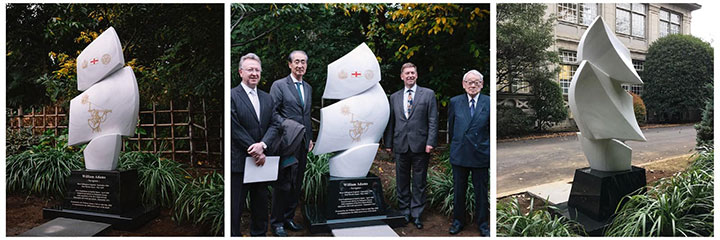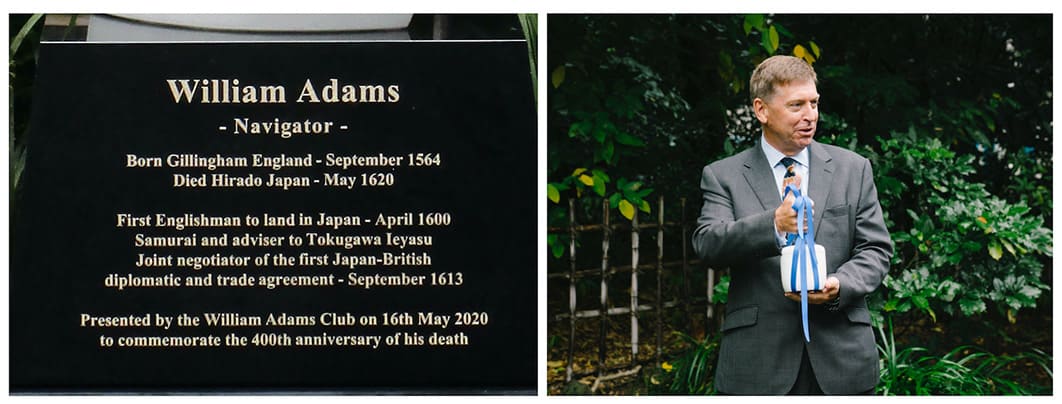Member? Please login
William Adams memorial sculpted by Kate Thomson of Ukishima Sculpture Studios

Kate Thomson with husband and fellow sculptor, Hironori Katagiri (Photo by Shu Kato)
Written by Abhijay Sandilya
December 9, 2020
UK-Japan Relations
On 25th November 2020, a memorial sculpture commemorating the 400th anniversary of the death of William Adams was unveiled at the British Embassy in Tokyo (postponed from 16th May 2020 due to Covid 19).
In the morning, British Ambassador Paul Madden inserted a beautifully crafted ceramic urn containing some of the earth from Adams’ recently excavated grave in Hirado, inside the base stone before the sculpture was installed.
BCCJ member Kate Thomson of Ukishima Sculpture Studios, described the project, commemorating the first Englishman to land in Japan in April 1600 as an honour.
“Commissioned by Robin James Maynard MBE, Founder of the William Adams Club, I suggested a sailing ship, to represent Adams, and celebrate the friendship between our two maritime island nations, which Adams helped to establish when, together with Captain John Saris of the East India Company, he negotiated the first Japan-British diplomatic and trade agreement of September 1613 on behalf of King James VI & I.
Set on a base of Indian black granite, I carved the sculpture from one block of Balkan White marble (from Macedonia) carefully chosen so the soft grain implies a cloudscape reflected on the ship, gives the impression of light radiating from the guiding sun, and accentuates the sense of the wind driving the sails, and the good relationship between Japan and the UK, forward.

The William Adams Club also wanted to include several key symbols:
On the topsail, to the left as you look at it, is the Tokugawa Crest, drawn from the original crest used by Ieyasu Tokugawa which was kindly provided by the WAC Treasurer, Yasuhisa Tokugawa Esq. the great-grandson of the last shogun. In the centre is the flag of St. George, which Adams travelled under and raised wherever he stayed in Japan. On the right is the Mulberry Leaf crest of the Hirado based Matsura clan, who gave William Adams vital support, including protection from those opposed to foreigners, and loans of money and men. On the main sail is an image based on 16th century illustrations in Captain John Davies’ book “The Seaman’s Secrets” of a navigator using a back-staff, the precursor to the sextant.
Many thanks to Robin James Maynard MBE, Professor Richard Irving, and Professor Tim Minton OBE for all their patience researching, and checking, all the above were historically correct before being set in stone, to the members of the William Adams Club for all their contributions and to Ambassador Paul Madden CMG FRSG and all at the Embassy for their support and help.”

William Adams
William Adams (24 September 1564 – 16 May 1620), known in Japanese as Anjin Miura(三浦按針: “the pilot of Miura”), was an English navigator who in 1600 was the first of his nation to reach Japan. One of a few survivors of the only Dutch East India Company ship to reach Japan from a five-ship expedition of 1598, Adams settled there and became the first ever (and one of the very few) Western Samurai.
Surviving Jesuit attempts to execute him, Adams was appointed as a Samurai, translator and adviser to Tokugawa Ieyasu and given the honorific name Anjin Miura. His fascinating, adventurous life in Japan also inspired the 1980s TV series Shogun.
Further reading: William Adams: the first Briton in Japan – Paul Madden, British Ambassador to Japan






